There's a kind of exoplanet out there that is suspiciously rare. We call them "hot Neptunes", and only a few have been discovered among the 3,869 confirmed exoplanets.
But astronomers have made an eye-watering discovery of an evaporating planet that could prove to be the missing link. Called Gliese 3470 b, this planet is losing its atmosphere at a staggering rate, faster than any we've observed before.
Judging by how rapidly this planet is vanishing, it lends weight to the hypothesis that the reason we've seen so few hot Neptunes is because they've actually shrunk into mini-Neptunes - one of the most common kinds of exoplanet discovered by the Kepler mission.
"The question has been, where have the hot Neptunes gone?" said astronomer Vincent Bourrier of the University of Geneva in Sauverny, Switzerland. "If we plot planetary size and distance from the star, there's a desert, a hole, in that distribution. That's been a puzzle."
A hot Neptune is pretty much what it sounds like. A giant planet, around the size and mass of Neptune or Uranus, but much, much closer to its host star - closer than the distance between Earth and the Sun. Therefore, it's also hotter, with an atmospheric temperature of around 927 degrees Celsius (1,700 Fahrenheit).
There are other Neptune-ish planets out there, but they're generally found orbiting much farther from their star. So either hot Neptunes are just rare in general; or they do form, but then they vanish somehow.
Or metamorphose into something else, as per the latest discovery. Gliese 3470 b (GJ 3470b for short) is not the only evaporating planet we've found. There's also Gliese 436 b, which was actually spotted leaking a few years ago, but not at a particularly fast rate.
An international team of astronomers has discovered that GJ 3470b, although at a similar distance from its star to GJ 436b, is much hotter - and losing its atmosphere at 100 times the rate, according to Hubble observations that reveal a cloud of hydrogen blowing out into space around the planet.
If it keeps going, it could end up as a mini-Neptune, or even a super-Earth, the team projects.
"This is the smoking gun that planets can lose a significant fraction of their entire mass," said physicist and planetary scientist David Sing of Johns Hopkins University.
"GJ 3470b is losing more of its mass than any other planet we seen so far; in only a few billion years from now, half of the planet may be gone."
Both planets orbit at a distance of around 6 million kilometres (3.7 million miles) from their stars (just over 10 percent of the distance between the Sun and Mercury, 58 million kilometres), but GJ 436b orbits an old red dwarf, a relatively cool and stable star between 4 and 8 billion years old.
GJ 3470b orbits a much younger star, a red dwarf only 2 billion years old. It's much hotter and more turbulent, which means GJ 3470b is treated to much more blistering radiation. The result of this - seen in other evaporating planets - is that the atmosphere is heated to the point where it boils away.
In addition, although the two planets are of comparable size, GJ 3470b is less dense than GJ 436b, which means its gravitational hold on its atmosphere isn't as strong. It's a result that confirms that atmospheric escape plays a major role in the lack of hot Neptunes, Bourrier said - and one that contributes to our understanding of the way planets change.
"I think this is the first case where this is so dramatic in terms of planetary evolution," Bourrier said.
"It's one of the most extreme examples of a planet undergoing a major mass-loss over its lifetime. This sizable mass loss has major consequences for its evolution, and it impacts our understanding of the origin and fate of the population of exoplanets close to their stars."
The team hopes to expand on their research by using the James Webb Space Telescope, which is scheduled for launch in 2021. Its more sensitive instrumentation could detect escaping helium, which could extend the search for escaping atmospheres to mini-Neptunes.
The team's research has been published in the journal Astronomy & Astrophysics.
